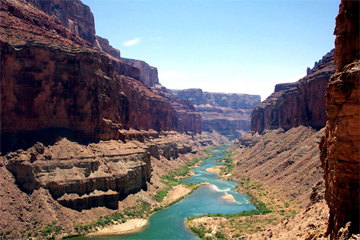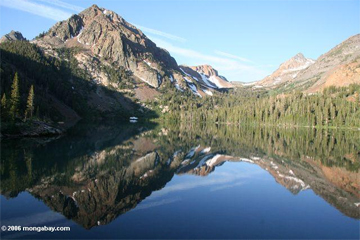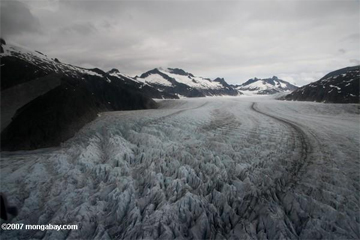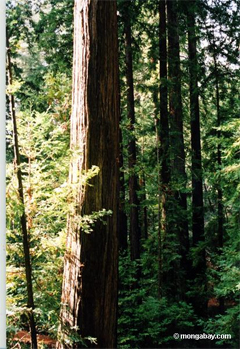In final weeks, President Bush aims to extend his environmental legacy
Jeremy Hance, mongabay.com
November 9, 2008
The Bush Aministration works feverishly in final weeks to undue laws protecting the nation’s environment and wildlife.
|
|
On Tuesday, November 4th, the people of the United States elected a new president, Senator Barack Obama. Many feel a new day is coming on a number of issues, including the environment. However the Bush Administration has 72 days left in its term and appears hopeful to use every one of those to make last-minute changes to environmental rules that will have wide-ranging impacts on the nation's endangered species, air, water, parks, and undeveloped land. As the administration has done since taking office eight years ago, it is working toward such policies—all of them controversial—to benefit industry at the cost of the environment and health safeguards.
Land Development and Mining
 A place to mine and dump? |
In September Congress lifted the ban on oil shale development. The Bush administration intends to make use of this change in the weeks before the transition to Obama's administration: the Department of the Interior (DOI) plans to grant concessions to develop oil shale on two million acres of public land. Oil shell development seeps metals and toxins into the ground and water, releases more greenhouse gases than other methods of petroleum extraction, and requires large quantities of water. Included in the development of public lands for oil share is an intention to bypass the required public comment period.
DOI is also planning changes regarding mountaintop removal for coal mining. Mountaintop removal is a relatively new mining process, begun in Appalachia in the 1970s. The process involves clear-cutting forests on mountain peaks and then blowing the mountain tops off in order to reach the coal inside.
Currently the law requires that mountain top removal mining does not dump anything within a hundred feet of any stream. The rule change proposed by the DOI, however, will allow such dumping in water sources if the company states it cannot avoid the stream and that it is "mitigating" any harm done. The new proposals would even allow changing an entire river's course in order to mine, potentially affecting wildlife and water quality.
 Dump here. |
The administration is also moving aggressively in development in Utah's natural lands. Currently, 40-45 different projects, incorporating 11 million acres of federal land, are being readied for development, roads, oil, and gas development by the Bureau of Land Management. Many of the projects are on the edges of Utah's most famous parks: Arches National Park, Dinosaur National Monument, and Canyonlands National Park.
America's Air
Pollution from power plants has also been on the Bush administration's radar. According to a report in the Wall Street Journal, the Environmental Protection Agency (EPA) had been looking at rule-changes for the New Source Review (NSR), a program that was intended to mitigate pollution from power plants.
The EPA plans to change a detail in the rulebook that would essentially exempt all power plants already running from having to install new technology to curtail pollution. Under the new rule, the NSR would require power plants to keep an eye on hourly rates, rather than annual rates, allowing power plants to increase annual emissions without repercussions.
The EPA is also planning to have no restriction on “fugitive” emissions from power plants. “Fugitive” emissions are those that come from any other source than smoke stacks, such as pipes. In other words, any toxins that come from these other sources would not be counted toward the power plant's total pollutants nor would there be any pollutant ceiling where at “fugitive” emissions must be curtailed.
The administration is also attempting to lessen rules regarding air pollution near national parks. The EPA hopes to incorporate new rules that would allow power plants, and their pollution, to be built closer to America's parklands.
Endangered Species
The Bush Administration has been denying and weakening protection for endangered species for eight years. Now, before its final term runs out the administration is working overtime to leave a lasting imprint on the act itself.
Although increasing number of American species are threatened by climate change—the polar bear, pika, and numerous amphibian species, among others—the administration plans to add rules to make it impossible for the Endangered Species Act (ESA) to be used in anyway to regulate CO2 emissions.
 Once all the ice is melted, could this be a site for gold mining? |
While such rules would have long-lasting impacts on preserving America's wildlife, the greatest threat to the ESA is the administration's plan to remove the requirement for scientific reviews in many situations, instead granting governments and developers the ability to ‘assess' the risk to species on developing projects. In essence, the new rule assumes that scientists are unnecessary when it comes to understanding the affect of development on various endangered species and instead places all the power over our nation's dwindling species in developer's hands.
The administration is also continuing battles regarding particular species. Despite a recent court order to put wolves back under the ESA's protection, the administration is continuing its fight to de-list wolves, which would allow them to be hunted. The administration is allowing only a thirty day comment period regarding the de-listing. Conservationists believe that hunting wolves in the lower forty-eight at this time would threaten the stability and longevity of wolf populations, while the Fish and Wildlife Service states that they have achieved their objective in having at least 300 wolves in the Rocky Mountain region.
What's Next?
Conservationists do not believe the Bush Administration's rule changes and plans for land development plans are at an end. Many suspect a number of further announcements. In fact, the most recent took place on election-day when the Bureau of Land Management released new maps updating their plans in Utah, including development in the areas adjacent to parkland.
 A potential logging site? |
Some decisions by the Bush administration have actually pushed developers and environmentalists together. Loggers and conservationists have both agreed that the administration's decision to ignore the Endangered Species Act when it came to increased logging in Oregon is problematic, at best. The Western Oregon Plan Revision and conservationists both argue that the area should be studied to make certain logging won't affect salmon and the northern spotted owl. The timber companies believe it is in their best interest to have the review done in order to avoid possible derailment of the project in future, while environmentalists want assurance the endangered species won't be negatively affected.
President-elect Obama will have the opportunity to overturn some of these rule changes when he takes office. But the process can be laborious, fraught with difficulty, and sometimes even impossible. For example, once land is sold to a oil or mining company a new administration cannot simply demand it back. In other words, Bush's dubious environmental legacy is likely to live well beyond his presidency.